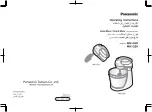
13
Owner’s Manual
Owner’
s Manual
Front Panel Features
Connection Section
This is where you plug things in: microphones, line-
level instruments and effects, headphones, and the
ultimate destination for your sound: PA system, stage
monitors, effects processors, CD player/recorder, etc.
See Appendix B for further details and drawings of
the connectors you can use with the ProFX mixer.
6. MIC INPUTS
We use phantom-powered, balanced microphone
inputs just like the big studio mega-consoles, for exactly
the same reason: This kind of circuit is excellent at re-
jecting hum and noise. You can plug in almost any kind
of mic that has a standard XLR male mic connector.
Professional ribbon, dynamic, and condenser mics will
all sound excellent through these inputs. The ProFX
mixer’s mic inputs will handle any kind of mic level
you can toss at them, without overloading. Be sure to
perform the gain-setting procedure on page 3.
PHANTOM POWER
Most modern professional condenser mics require
phantom power, which lets the mixer send low-cur-
rent DC voltage to the mic’s electronics through the
same wires that carry audio. (Semi-pro condenser mics
often have batteries to accomplish the same thing.)
“Phantom” owes its name to an ability to be “unseen”
by dynamic mics (Shure SM57/SM58, for instance),
which don’t need external power and aren’t affected by
it anyway.
The ProFX mixer’s phantom power is globally
controlled by the phantom power switch [32]. (This
means that phantom power for all the mic inputs is
turned on and off together.)
Never plug single-ended (unbalanced) micro-
phones, or ribbon microphones into the mic
input jacks if phantom power is on. Do not
plug instrument outputs into the mic input jacks with
phantom power on unless you know for certain it is safe
to do so.
7. LINE/HI-Z SWITCH
To connect a guitar directly to the mixer without us-
ing a DI Box, press this switch in fi rst, then connect the
output from your guitar to channel 1's 1⁄4" TRS input
[8]. The input impedance is then optimized for direct
connection, and high-frequency fi delity is assured.
In the out position, channel 1's 1⁄4" TRS input be-
comes a line input just like the other mono line inputs
[9].
To use guitars or other instruments on other chan-
nels, you will need to use an external DI box fi rst.
Without the DI box, (or if this switch is not pressed in)
guitars may sound dull and muddy.
8. LINE/HI-Z INPUT (Channel 1 only)
This 1/4" jack shares circuitry (but not phantom
power) with the mic preamp, and can be driven by bal-
anced or unbalanced sources.
To connect a balanced line to this input, use a 1⁄4"
Tip-Ring-Sleeve (TRS) plug.
To connect an unbalanced line to this input, use a 1⁄4"
mono (TS) phone plug or instrument cable.
This line-level input can also accept instrument-level
signals if the hi-z switch [7] is pressed in. This allows
you to connect guitars directly into channel 1 without
the need for a DI box.
TAPE
IN
ST RETURN
MAIN OUT
PHONES
FOOTSWITCH
TAPE
OUT
L
R
L
(UNBALANCED)
R
FX SEND
LINE IN 4
INSERT
BAL /
UNBAL
(MONO)
(MONO)
(MONO)
(MONO)
LINE IN 7
LINE IN 8
BAL /
UNBAL
LINE IN 9
MIC
MIC
MIC
MIC
MIC
MIC
L
R
(MONO)
LINE IN 5
LINE IN 6
BAL /
UNBAL
L
R
LINE IN 10
BAL /
UNBAL
L
R
LINE IN 11
LINE IN 12
BAL /
UNBAL
L
R
BAL /
UNBAL
L
R
BAL /
UNBAL
L
R
MON SEND
BAL /
UNBAL
BAL /
UNBAL
4
LINE IN 3
INSERT
BAL /
UNBAL
3
LINE IN 2
INSERT
BAL /
UNBAL
BAL /
UNBAL
2
LINE/HI-Z IN 1
INSERT
1
5/6
7/8
9/10
11/12
LINE
HI-Z
PROFESSIONAL MIC/LINE MIXER WITH FX
7
6
8
11
9
9
9
10
10
10
11
11
11
10














































